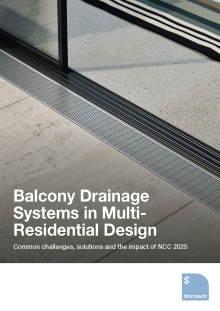
Moreover, poor drainage flow, resultant from substandard drainage design and placement, remains the chief cause of ponding, which can degrade impervious surfaces and cause serious structural damage to any property. Here are some of the key considerations for your outdoor drainage project to help architects, specifiers, builders and skilled DIY practitioners select and implement the best drainage solutions.
1. Drainage Layout & Availability
One of the chief considerations for outdoor drainage sites is their access to existing plumbing and drainage systems.
The advantage of new building sites is that most allow for drainage systems to be established in order to meet the ‘lay of the land’, ensuring maximised water flow and adherence to best practice water-sensitive design principles (WSUD). However, older properties may offer fewer possibilities for alteration, and may be better suited to more traditional drainage arrangements.
Building surfaces (such as earth, stone or concrete) will also impact one’s ability to move or increase the number of available drains.
2. Use of Outdoor Area
If your drainage area is heavily trafficked or used for vehicular access/parking, it is critical to ensure your drainage solution can bear the weight of these excessive loads.
Many drainage solutions offer superior load ratings to ensure they can withstand these load forces and avoid buckling even under constant load pressures.
3. Environmental Concerns
Australia’s unique environmental challenges will greatly impact on the type of drainage materials and grating required for your outdoor area.
Key external variables such as exposure to airborne salinity (i.e. proximity to seashore), tree debris (e.g. leaves and seeds), exposure to urban pollutants (e.g. PAHs and corrosive chemicals) and even weather (dry arid versus wet tropical) conditions will all have a significant impact on the type of drainage you require and the materials best suited to withstand these unique environmental conditions.
Boasting an unrivaled depth of experience with linear drainage solutions, Stormtech welcomes questions about product selection and compliance, and can advise prospective clients on the most suitable drainage product for your building project.
Our skilled specialists work closely with specifiers, architects and builders to offer tailored drainage solutions, including bespoke drawings and plans for customised drainage designs. We work proactively with plumbing advisory services to ensure drainage is not only fit for purpose, but meets stringent Building Code of Australia (BCA) compliance measures.







